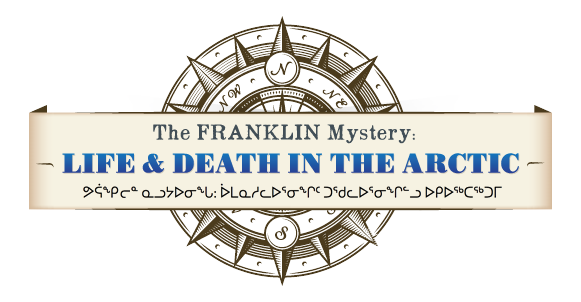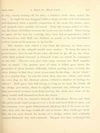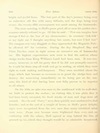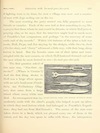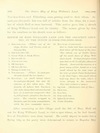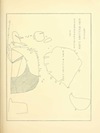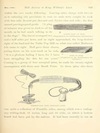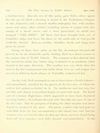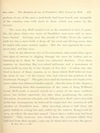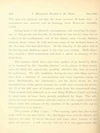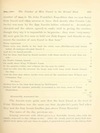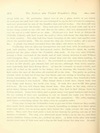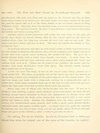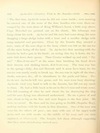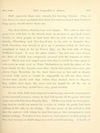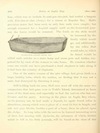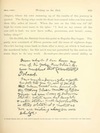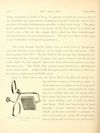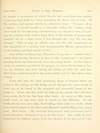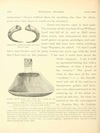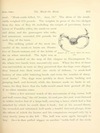Hall meets Innookpoozhejook, interviews other Inuits, finds relics (1879)
Interview with In-nook-poo-zhe-jook.
April 1869.
The Inuits now asked a rest from the journey to hunt more musk-cattle, as the animals would soon scatter. To keep the men in good humor, Ou-e-la and Pa-pa were allowed to go off on the hunt, while Hall pushed forward to Grinnell Lake, on which he encamped on the 22d. The two men met with some success, but Hall remarks that, as usual, "the greater part of what is killed goes down the paunches of these Inuits, although, before getting leave to hunt, the story always is that they want to get meat for the dogs. As for "Jack," he is a regular hog ; he eats far more than any two others, and feeds his own dog on the choicest pieces, without a shadow of feeling for others." Hall gave him full swing, so long as he kept his hands off the sledge provisions; these he rigidly rationed out, although he was thus prevented at times even from leaving the sleds, lest some of the party would stuff themselves from the stores.
On the 27th, he crossed a branch of Murchison River, and from this point made rapid progress over a level and hard field of snow, yet his company were again disheartened, thinking that if he went on further, they and the dogs would all starve before they could get back. But Ou-e-la soon found the tracks of a sledge which had evidently crossed Richards' Bay and returned. Despair was then exchanged for bright and joyful faces. The last part of the day's journey being over an unbroken old floe with many hillocks, and the dogs being very weary, the twenty-fifth encampment was made among the hummocks.
[ … ]
On the 30th, an igloo was seen to the southward with its wall-shelter built to protect the sealers ; on visiting this, it was plain that it had been lately occupied, for fresh tracks of men and dogs were all around. Ou-e-la and "Jerry" were then quickly sent southward to find Inuits ; and at the end of a couple of hours, to Hall's great delight, signs were recognized from the two men that many inhabited igloos were seen. Pa-pa now became more frightened than ever, and, on conferring with the others, Hall agreed to stop behind the line of pressed-up ice, which they thought would be an admirable breastwork if fighting were to be done, for now a village was seen and a number of men with dogs sealing out on the ice.
May, 1869.
The next morning the party started out, fully prepared to meet friends or enemies. Each of the men had at first something to say like a prayer that those whom he met would be friends; in which Hall joined, praying also, as he says, that the interview might lead to much news of Franklin's lost companions, and perhaps "to the recovery of some souls and of the records." Within 150 fathoms of the igloos a halt was made, Hall, Pa-pa, and Joe staying by the sledges, while Ou-e-la, Jack (Nu-ker-zhoo), and "Jerry" advanced a little way, with their long, sharp knives in hand. But the Inuits came out of their igloos and intermingled with the new-comers, on which Hall hastened forward and met the man whom he most desired to see — In-nook-poo-zhee-jook.
The first question asked of this man was, "Nou-tima Ag-loo-ka?" (Where is Crozier)? And the first thing shown to Hall was a large silver spoon, with an eel's head crest (Franklin's; see Preliminary Chapter), that came from a large island where many white men died. An encampment was immediately made with the chief's people, who helped to put up igloos, in which they used knives which had belonged to Franklin's Expedition ; they had one from McClintock's. The names of the men were taken down in a book, which act pleased every one of them at the outset, and the day was spent in talks with them ; the interpreters, Too-koo-li-too and Ebierbing, soon getting used to their idiom. In-nook-poo-zhee-jook's hut was full of articles from the ships, for a number of which Hall at once bartered. This native gave him a sketch of King William's Land and its vicinity. The names given by him for the numbers on his sketch were as follows:
SKETCH OF KING WILLIAM'S LAND AND THE ADJACENT COUNTRY, BY THE INNUIT IN-NOOK-POO-ZHEE-JOOK.
- Kee-wee-woo. (Where one of the ships, Erebus and Terror, sunk at Ook-joo-lik.)
- Oot-koo-ish-e-lik.
- Great Fish or Back River.
- See-er-ark-tu.
- Noo-oo-tee-roo.
- Ok-kee-jeer.
- Ok-kee-jik-too.
- Shoog-ee-look-too.
- Too-noo-nee. (Where In-nook-poo-zhee-jook found the two boats)
- Kee-ǔ-na. (A small island where In-nook-poo-zhe-jook has seen the remains of five white men. The Inuits all believe that Too-loo-a (Sir John Ross) died and was buried here. (!) A meat-can unopened — that is, full of meat — found in Too-loo-a's grave. His remains wrapped in blankets, and his body unmutilated, while the four remainder were — that is, limbs had been severed and flesh taken off the bones of the four. This island, one of Todd's Islets, off the south shore of King William's Land. No boat found or white men died on Ki-ki-tǔk-jūa (Montreal Island). Boat and the remains of a great many whites found on a very small island by the west coast of the inlet of which Point Richardson is the East Cape ; this small island half way down the inlet, where it turns sharply to the westward. This islet without a name.)
- Og-buk. (Matheson's Isle of Rae)
- Shar-too.
- Koo-kar.
- Ook-sook-too.
- Igloo-le-ar-choo.
- Point Dryden.
Hall Arrives at King William's Land.
After remaining at this village until the 8th of May, Hall set out for King William's Land, to visit a spot where, as he had heard, five of Franklin's men were buried. He could expect to make but a flying trip, as his party were determined to return to Repulse Bay within the two weeks following. Leaving strict charge with Ou-e-la as to rationing out provisions in case no seals were caught, he took with him only In-nook-poo-zhee-jook and Nu-ker-zhoo and wife; the first named proving a good guide. "A plug of tobacco was given to Jack to oil his mouth, as he had much talking to do to the dogs." The travel averaged two and a half miles per hour, and as night approached, the long-desired sight of the land and the Table-Top Hill on what was called Matheson Isle came in sight. Hall gave three cheers, jotting down on his note-book as he rode, "It is a glorious feeling I have, for I have been struggling for this for ten years." Coming to a group of four occupied igloos, he made his twenty-eighth encampment with them near Booth Point. In these igloos also there was quite a collection of Franklin relics, among which was a mahogany writing-desk, 18 inches long and 10 wide, on which a bottom board had been put by the natives. It had been recently in use as a blubber-tray. Koo-nik, one of this party, gave Hall a silver spoon like the one of which a drawing is found in the Preliminary Chapter of this Narrative, and a second smaller mahogany box, with another spoon and many other articles, including pieces of copper with two stamps of a broad arrow, and a steel spear-head on which was stamped "THE SHIP." All these had been brought from one of Franklin's ships and from the shore on the south side of Ook-joo-lik (O'Reilly Island). Knives, needles, thimbles, beads, and rings were given in return.
Going on from these igloos on the 9th, In-nook-poo-zhee-jook still proved to be an admirable guide, leading Hall on a direct course to the eastern islet of Todd's Islands. The compass at first showed that the travel was south, but before long it showed it as northeast when headed in the same direction. The weather was very thick when the next to the last encampment was made about 10 a. m., and supper was served on delicious fresh salmon of Neitchille, cooked and hot.
On the 11th, Hall encamped on one of these islets — Todd's Island — and immediately searched for the graves of the five men of whom the natives had spoken as buried on it. Its northwest end was very low and flat, and almost everywhere deeply covered with snow. He found part of a human thigh-bone, which appeared to have been fractured not long before; In-nook-poo-zhee-jook told him this was part of one of the five men. But the prospect of finding the other remains was abandoned on account of the snow. Poo-yet-ta, a native who had gone on with Hall from his last encampment to this island, now said that the remains were not buried when he first saw them, but were found lying down all close together, each fully dressed and unmutilated. In the pockets of one of the men a jack-knife had been found, and alongside of the remains, cans with meat in them which was eaten by the Inuits.
The next day Hall crossed over to the mainland to find, if possible, the place where two more of Franklin's men were said to have been buried. Arriving near the mouth of Peffer River, the natives built for him a snow-wall to keep off the wind and driving snow, that he might take some sextant angles. But the sun appeared for a moment only, and but once.
Late in the afternoon two of his attendants, after much labor, gave him signs of success in digging through the snow for bodies, and on hastening up to them he found one unburied skeleton. Over these remains an American flag was raised half-mast, and a monument of stones built up near by to the height of five feet. A salute was also fired in honor of these remains as to those which Hall believed were the form of one "of the heroes who had solved the problem of the Northwest Passage." The gale above and the hardness and depth of the snow under foot debarred further search. (See the close of this chapter.)
Returning from this examination of the coast of King William's Land, Hall made a second search on a point of the same southern shore, but farther eastward ; for, after close questioning the natives Poo-yet-ta, In-nook-poo-zhee-jook, and Tǔk-pee-too a third native met with at his last encampment, he believed he might find the remains of still another of Franklin's men. After traveling about a half hour, the party halted on a long low spit, called by the natives Kung-e-ark-le-ar-u, on which the men last named "knew that a white man had been buried." This, however, was chiefly from the accounts which they had had from their people ; only one of these had ever seen the grave. The spot was pointed out, but the snow covered all from view. A monument was erected, and its bearings from Kee-u-na carefully noted.
Going back to the thirtieth encampment, and renewing his inquiries of Tuk-pee-too and his wife, E-vee-shuk, he was led by these two to a place on the southeastern end of the island, some twenty fathoms from the shore, where the wife had seen some of the skeleton bones of the five men who had died there. Of the identity of the place and of her having seen skeletons upon it she was very certain. Hall, therefore, erected a third monument and fired a salute in memory of the dead there.
The remains which have now been spoken of as found by Hall, or as honored by his "humble tributes" at the places of their burial, were all which his opportunity possibly afforded him time to search for and honor. He felt confident, during his stay with these natives, that, from a number of conversations and close inquiries (using in these McClintock's, the Admiralty's, and Dr. Rae's charts for the identifications of the places named), he could now account for probably 79 of the 105 men of Crozier's party from the abandoned ships. Their remains had whitened at or near King William's Land, and had, in some cases at least, been grossly mutilated by dogs. The substance of some conversations with the natives of this region which led him to make this estimate of the number of the perished who can be accounted for is as follows:
[ … ]
I will now try and see if I can approximate the number of men in Sir John Franklin's Expedition that we now know from Inuit and other sources to have died shortly after Crozier (Ag-loo-ka) was seen by the four Inuits before referred to. In-nook-poo-zhee-jook and the others agreed to make trial in giving the number, though they say it is impossible to be precise ; they were 'very many.' He now gets his five men to hold out their fingers and thumbs to represent the number of men found in that boat."
| These represent | ......... | 50 |
| There were two skulls in the boat the white man (McClintock) had found before In-nook-poo-zhee-jook found it | ......... | 2 |
| And five he found outside | ......... | 5 |
| Not far from that boat he found another with three skulls in it and four outside | ......... | 7 |
| On Todd's Island, buried | ......... | 5 |
| On south shore King William's Land | ......... | 2 |
| If the number within and without the big tent be called | ......... | 30 |
| And we take into the account the large man with long teeth found aboard the ship | ......... | 1 |
| And the four men whose tracks were seen on the mainland near Wilmot and Crampton Bay | ......... | 4 |
| We have | ......... | 106 |
| Deduct two in the boat first found by McClintock | ......... | 2 |
| Deduct half the number probably overstated in the boat, west of Point Richardson | ......... | 25 |
| ---- 27 | ||
| _____ | ||
| Reasonably accounted for | ......... | 79 |
The Inuits were quite sure that the boat found at the west of Point Richardson was the same one that Ag-gloo-ka's party had when they met the four Inuit families just above Point Herschel.
The notes of the day previous are:
Evening interview with Ek-Kee-pee-re-a, a Neitchille Inuit, who, with his family, removed to this village to-day. After the newly arrived party had completed their igloos and got them to rights, I proceeded to make a call, taking Jack along with me. My particular object was to see a glass bottle or jar, which In-nook-poo-zhee-jook had told me once belonged to Ag-loo-ka's (Crozier's) company, and now possessed by one of the families that arrived to-day. Our first call was on the old man and his family. They had part of a file 1 ¼ inch wide and 2 ½ or 3 inches long, round on one side and flat on the other ; this was sharpened on one end for use as a cold chisel or an adze. Ek-kee-pee-re-a had lived at Ook-joo-lik (O'Reilly Island), and had heard the natives there tell about the ship that came to their country. The ship had four boats hanging at the sides and another was above the quarter-deck. The ice about the ship one winter's make ; all a smooth floe. A plank was found extended from the ship's side down to the ice.
Gathering into an igloo my interpreters Joe and Jack with In-nook-poo-zhee-jook, and putting before the last-named native McClintock's chart, he readily pointed out the place where the Franklin ship sank. It was very near O'Reilly Island, a little eastward of the north end of said island, between it and Wilmot and Crampton Bay. A native of the island first saw the ship when sealing; it was far off seaward, beset in the ice. He concluded to make his way to it, though at first he felt afraid ; got aboard, but saw no one, although from every appearance somebody had been living there. At last he ventured to steal a knife, and made off as fast as he could to his home ; but on showing the Inuits what he had stolen the men of the place all started off to the ship. The party on getting aboard tried to find out if any one was there, and not seeing or hearing any one, began ransacking the ship. To get into the igloo (cabin), they knocked a hole through because it was locked. They found there a dead man, whose body was very large and heavy, his teeth very long. It took five men to lift this giant Kob-lu-na. He was left where they found him. One place in the ship, where a great many things were found, was very dark ; they had to find things there by feeling around. Guns were there and a great many very good buckets and boxes. On my asking if they saw anything to eat on board, the reply was there was meat and tood-noo in cans, the meat fat and like pemmican. The sails, rigging, and boats — everything about the ship — was in complete order.
From time to time the Neitchilles went to get out of her whatever they could; they made their plunder into piles on board, intending to sledge it to their igloos some time after; but on going again they found her sunk, except the top of the masts. They said they had made a hole in her bottom by getting out one of her timbers or planks. The ship was afterward much broken up by the ice, and then masts, timbers, boxes, casks, &c., drifted on shore. A little while after this fresh tracks were seen of four men and a dog on the land where the ship was. In-nook-poo-zhee-jook, who had seen Ross and his party on the Victory and Rae in 1854, knew these tracks to be kob-lu-nas'; the foot-marks were long, narrow in the middle, and the prints like as if of the boots found in the two boats found on King William's Land. One man, from his running steps, was a very great runner — very long steps. The natives tracked the men a long distance, and found where they had killed and eaten a young deer.
Another native at this interview told nearly the same story of the ship and of the man found on board, adding that he was found dead on the floor, his clothes all on ; that the ship was covered all over with sails or tent stuff. The cabin was down below and not on deck. The time was about the middle of May or first of June.
In-nook-poo-zhee-jook said that he had found a boat (a little way westward of the one found by Hobson), the planks, ribs, and all complete, and copper fastened. In the boat were a great many skeletons, the skulls with them. He gave me a double-bladed knife, with a white bone handle, very rusty. It came from this boat. The boat had not been touched, and a great many papers and books and written stuff were in it. [These are all trash to the Inuits ; the winds and the weather had made destructive work with them. The Inuits would trample them under feet as if grass.]
A tent was near this boat ; it was on the top of some rising ground on a small sandy hill. The place, as pointed out on the chart, was near the bottom of Terror Bay, a little way northerly of the point adjacent to Fitz-James Inlet. The tent was large, and made with a ridge-pole resting on a perpendicular pole at either end ; small ropes extended from top of the tent at each end to the ground, where the rope-ends were fast to sticks driven into the ground.
Three men, one of whom was Tee-kee-ta, first saw the tent. It had in it blankets and bedding, a great many skeleton bones and skulls, the flesh all off ; nothing except sinews attached to them ; the appearance as though foxes and wolves had gnawed the flesh ; some bones had been sawed with a saw ; some skulls had holes in them. Besides the blankets, were tin cups, spoons, forks, knives, two double-barrel guns, pistols, lead balls, a great many powder-flasks, and both books and papers written upon. As these last were good for nothing for Inuits, the men threw them away, except one book, which Tee-ka-ta brought home and gave to the children ; after a while it got torn to pieces.
On asking Tee-kee-ta whether Ag-loo-ka (Crozier) had a telescope about him when he visited one of the tents of the Inuits, he replied :
"The first time Ag-loo-ka came he did not come inside ; next morning he entered one of the tents of the four families who were there encamped by the west shore of King William's Land, a little way above Cape Herschel (as pointed out on the chart). His telescope was hung about his neck. Ag-loo-ka and his men had come along, the men dragging a large sledge laden with a boat and a smaller sledge with camp material and provision. Close by the Inuits they erected a tent ; some of the men slept in the boat, which was left on the sea-ice all the snow being off the land. On Ag-loo-ka's first meeting with the Inuits he had a gun in his hand; on seeing him lay it down, the Inuits laid down their spears. Then Crozier walked up and said, "Tij-mo?" "Man-ik-too-mee?" at the same time brushing his hand down their breasts and shaking hands, Kob-lu-na-way. The time was late in the spring — July, Joe and Hannah said it must have been, for the sea-ice was nearly ready to break up; the sun was in sight all the time ; ducks, now-yers, &c., all in abundance in the pools and lakes. Tee-kee-ta saw Ag-loo-ka kill two geese, and his men were busy shooting. Ag-loo-ka tried very hard to talk to the Inuits, but did not say much to them. He had a little book as he sat in Ow-er's tent and wrote notes. The full meaning of what he said about the ice destroying the ship and his men dying was afterward understood. He ate a piece of seal raw, about as big as the fore and next fingers to the first joint. He wore no sword. He then said he was going to Iwillik (Repulse Bay), making motions with his hands in that direction. One of his men was very fat, the others all poor ; one man with one of his upper teeth gone, and one with marks on the saddle of his nose, and one man squinted, or cross-eyed. The Inuits left them although supposing that they were abandoning starved men.
Hall reproved these men sharply for leaving Crozier. Does it not, however, seem probable that these few natives feared that Crozier's large party would starve them out.
[ … ]
On the 20th of June, 1869, this three months' journey was ended by Hall's arrival at his old quarters. After a friendly talk with the natives of the bay on whose shores he and his party were again safely quartered, he promptly wrote out for his friend Mr. Grinnell a letter which might reach the United States before he himself could return. It so fully states the facts of this weary but most important of his journeys, that its proper place seems to be at this point of the history.

